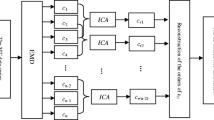Abstract
Non-invasive load monitoring and decomposition technology plays a very important role in the process of intelligent power grid construction nowadays. This paper explores the feature extraction of transient and steady state by using the data of known binary single electrical equipment state. Regarding to the steady state characteristic parameter extraction, the method of Fourier series decomposition is used to calculate the average active power and reactive power, and then make a parameter table of steady state power and later analyze waveform characteristics. Regarding to transient characteristic parameters extraction, Mallat algorithm is used to make an extraction of the disturbance waveform, with its high frequency coefficient as the difference between the transient and steady-state characteristic value, so as to estimate the duration of the disturbance directly. By extracting the two-state characteristics, this paper explores the load marks that can be used to distinguish different devices. More over, this article combines with many measured data to verify the results, which has made a satisfy.
Access this chapter
Tax calculation will be finalised at checkout
Purchases are for personal use only
Similar content being viewed by others
References
Hart, G.W.: Residential energy monitoring and computerized surveillance via utility power flows. IEEE Technol. Soc. Mag. 8(2), 12–16 (1989)
Niu, L., Jia, H.: Transient event detection algorithm for non-intrusive load monitoring. Autom. Electr. Power Syst. 35(09), 30–35 (2011)
Li, P.: Non-intrusive method for power load disaggregation and monitoring. Tianjin University (2009)
Wang, C., Guo, H., Zhang, W.: Research on power system short term load forecasting method based on wavelet decomposition. Hebei Electr. Power 29(02), 11–14 (2010)
Yu, Y., Liu, B., Luan, W.: Nonintrusive residential load monitoring and decomposition technology. South. Power Syst. Technol. 7(04), 1–5 (2013)
Lin, J.: Application of recognition model for power load in cluster ensemble and deep learning. South China University of Technology (2014)
Liu, B.: Non-intrusive power load monitoring and disaggregation technique. Tianjin University (2014)
Sheng, M.: Algorithm research of non-intrusive household appliances recognition. Ocean University of China (2015)
Xu, Y., Li, W., Li, D., You, X.: Disaggregation for non-invasive domestic appliances based on the improved chicken swarm optimization algorithm. Power Syst. Prot. Control 44(13), 27–32 (2016)
Cui, C.: Study on key technologies in non-intrusive residential load monitoring for intelligent power utilization. School of North China Electric Power University (2017)
Cheng, X., Li, L., Wu, H., Ding, Y., Song, Y., Sun, W.: A survey of the research on non-intrusive load monitoring and disaggregation. Power Syst. Technol. 40(10), 3108–3117 (2016)
Huang, Y., Li, W., Liang, Z., Xue, Y., Wang, X.: Efficient business process consolidation: combining topic features with structure matching. Soft Comput. 22(2), 645–657 (2016)
Bin, Z., Jing, S.: A power quality analysis method based on Mallat algorithm and fast fourier transform. Power Syst. Technol. 2007(19), 35–40 (2017)
Lei, D.: The research on algorithm of the NILM in circuit fault detection and household appliances power consumption monitoring. College of Electrical Engineering of Chongqing University (2012)
Tan, W., Xie, D., Xia, J., Tan, W., Fan, L., Jin, S.: Spectral and energy efficiency of massive MIMO for hybrid architectures based on phase shifters. IEEE Access 6, 11751–11759 (2018)
Author information
Authors and Affiliations
Corresponding author
Editor information
Editors and Affiliations
Rights and permissions
Copyright information
© 2018 Springer Nature Switzerland AG
About this paper
Cite this paper
Li, F., Zhang, W., Liu, H., Zhang, M. (2018). Feature Extraction of Dichotomous Equipment Based on Non-intrusive Load Monitoring and Decomposition. In: Hu, T., Wang, F., Li, H., Wang, Q. (eds) Algorithms and Architectures for Parallel Processing. ICA3PP 2018. Lecture Notes in Computer Science(), vol 11338. Springer, Cham. https://doi.org/10.1007/978-3-030-05234-8_24
Download citation
DOI: https://doi.org/10.1007/978-3-030-05234-8_24
Published:
Publisher Name: Springer, Cham
Print ISBN: 978-3-030-05233-1
Online ISBN: 978-3-030-05234-8
eBook Packages: Computer ScienceComputer Science (R0)




